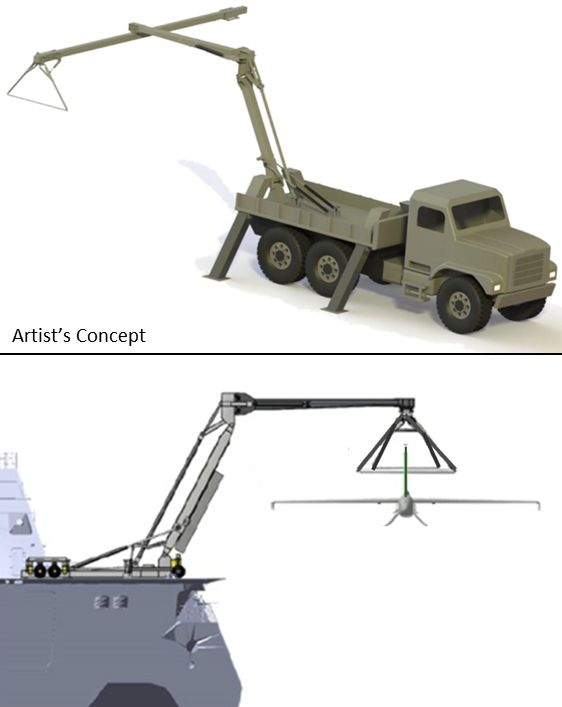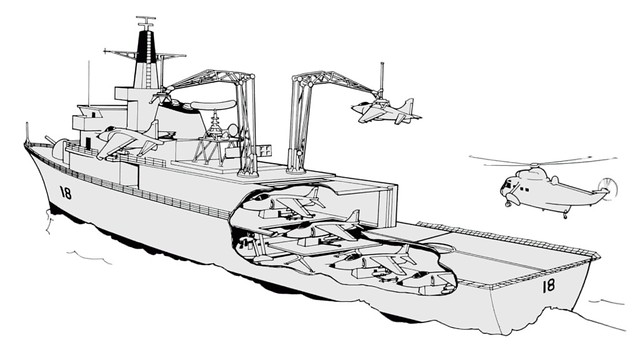Which came first, Side Arm or Sky Hook?

From DARPA
SideArm: DARPA’s SideArm effort seeks to create a self-contained, portable apparatus able to horizontally launch and retrieve UAS of up to 900 pounds from trucks, ships and fixed ground facilities. The small-footprint system is designed to enable rapid setup and controlled decelerations and adapt to current and future UAS. Based on subscale tests last summer, DARPA will conduct further risk reduction and hardware testing this year, and then plans to test recovery of two different aircraft types at full scale.
And a blast from the Sky Hook past…
Of course, there was also the FICON, arguably even more deranged!
httpv://www.youtube.com/watch?v=RcLCjnK_cik

@TD
Yes, I remember the old Sky Hook (from the 1970/80s, was it?). I don’t know that it was all that “deranged” an idea. Seemed quite an imaginative way of getting Harriers re-fuelled etc. without actually having them land vertically on a vessel’s deck (i.e vessels which were not flat-tops could employ it, Would have saved fuel too, no doubt.
As far as SideArm is concerned, if the idea is to “horizontally launch and retrieve UAS of up to 900 pounds from trucks, ships and fixed ground facilities”, then I am slightly puzzled over the “launch” bit of it. There seems to be no catapult shown in the diagram, so would the idea be that because the UAV would have its own engine, it could launch itself from the arm? The “retrieval” part I can understand better.
LikeLike
Now if that billionaires sub on the other post had a sky hook and a couple of F35B in a hangar there would be a queue round the block 🙂 As the F35B takes off and can land vertically by computer control only hovering for refueling next to a fuel boom kept static by a computerized arm should be achievable. A damm sight easier than the Harrier rig from 40 years ago.
LikeLike
Something like this?
http://forum.keypublishing.com/attachment.php?attachmentid=74085&d=1112976106
Cover shows an enlarged follow-on to Vanguard program equipped with Sky Hook launching/recovering a P.1216 ASTOVL.
EDIT: Second hand copies available from Amazon Marketplace:
Author: Terry C. Treadwell
Publisher: NPI Media Group
ISBN-10: 0752417045
ISBN-13: 978-0752417042
LikeLike
Re: Skyhook – we could convert the Type 45s. Hopefully we will be buying enough F-35s to equip all six of them – 2 each?
LikeLike
@WiseApe – don’t forget the T26 – that’s about 40 in addition to the 48 for the Carriers. A round hundred would be nice… 🙂
GNB
LikeLike
If I remember correctly the Soviets used a TB-3 bomber carrying two Po I-16 fighters quite sucessfully in 1941-2 – papa-FICON?
https://en.wikipedia.org/wiki/Zveno_project
LikeLike
If I remember correctly the Soviets used a TB-3 bomber carrying two Po I-16 fighters quite sucessfully in 1941-2 – papa-FICON?
https://en.wikipedia.org/wiki/Zveno_project
LikeLike
“All old hat.
The “Brodie landing system” allowed 3.5 ton observation aircraft to land on WWII LSTs (landing ship tank).
I am sure that there are other systems that did essentially the same thing – let’s filed the contraptions and get back to work.
LikeLike
Lots of cases where fighters were to hitch a ride on a flying carrier. The most obvious cases being the idea to clip a biplane under Zeppelins. Most of the ideas suffered a similar flaw, in that the fighter could be carried into its battles, but re-docking in flight being extremely tricky meant they’d have to fly themselves home, or ditch. The FICON is the only idea I’ve seen where the fighter was recovered in flight.
The UK had similar ideas in the 50s/60s – in this case Hen & Chicks were Vulcan and Gnats.
http://img.photobucket.com/albums/v187/Secudus/Vulcan01.jpg~original
LikeLike
It’s almost a wonder with all these drawings, trials and tests why we never seriously invested in the devices…
LikeLike
It almost reminds me of the USS Akron airship aircraft-carrier.
LikeLike
@GAB – A nice piece of video – thanks
Looks like they are using a Piper Cub – an ideal aircraft for that sort of work – it’s descendant, the Carbon Cub holds the XSTOL record at the moment, I think.
17 foot landing followed by 10 foot take-off in an 18kt wind
LikeLike
http://www.airships.net/us-navy-rigid-airships/uss-akron-macon
LikeLike
Well, cranes on ships date all the way back to when aircraft were seaplanes and had to be recovered via crane after a water landing, so neither are particularly new.
LikeLike
There was a PC game out in the 00’s called Crimson Skies that had ‘pirates’ that utilised USS-Akron like aircraft.
With airships attempting to come back into fashion, I think the idea of an Akron like craft should be revisited. You’d be able to combine a high-altitude, long-endurance radar, optics and potentially weapons (glide bombs) platform with the ability to launch and recover small manned-scout or UAV aircraft over an area of interest.
The big question in my mind is whether you’d look for complete automation, or if a small crew would be required on board.
LikeLike
The Sky Hook Harrier was deranged, because how could you ensure everything was connected properly before you dropped power? Their is also the question of fuselage strong points, and where exactly are you going to connect the contraption to the aircraft.
LikeLike
Small matter of ships not staying perfectly still…
LikeLike
I will admit I assumed the bright sparks in BAe or H-S (whichever) had thought the relative motion thing through and had servo stabilisation of the skyhook end of the jib. All the arty impressions seemed to have long jibs on the cranes, making it less likely to hit an endstop even in rough waters. As for certainty of attachment, if I remember right the test aircraft displayed in Brooklands museum has a stainless rail the full length of the wing root , around which the hooks would latch – a couple of mirrors on the canopy would probably have shown if the hooks had caught the rail successfully? Added to a bit of telemetry for a double check, naturally.
LikeLike
https://www.google.co.uk/url?sa=t&source=web&rct=j&url=http://m.youtube.com/watch%3Fv%3DaBn7w1S8MtY&ved=0CCQQtwIwAGoVChMI7qKa3JTixgIVswfbCh2xUAqf&usg=AFQjCNHfo9-OhgHlH69WnvwTO56HSZOQmQ
These devices and cranes working on the same principals are common in the offshore supply industry. One of the things that killed the original Harrier Sky Hook was reinforcing the airframe both on the top and below for its storage cradle. The extra weight although offset by the removal of the undercarriage was a limiting factor . Refueling in the hover mode similar to the common RN practice of refueling helicopters hovering of the stern of a ship should be possible for an unadulterated F35B. Dare I say it, a 20′ ISO containerized module on any ship with sufficient clearance could be made to work.
LikeLike
SD – a complete 6 DOF platform was more than I expected to be necessary, but it would be the best solution, give or take maximum ram motion available. I think a knuckled crane arm on a simple turntable ought to be able to hold the hook in a steady position in all axes though, with greater freedom of movement.
LikeLike